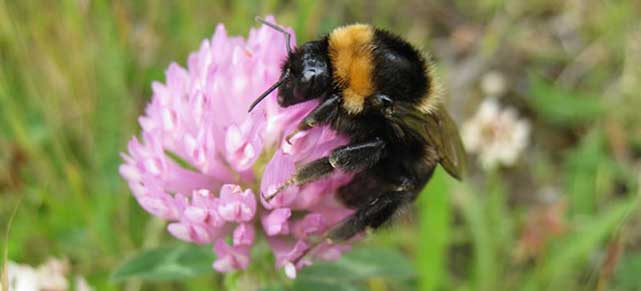This article originally appeared on ![]()
A species of bee declared extinct in the UK almost 30 years ago is flying again – thanks in part to the efforts of farmers. Researchers have been restoring the short-haired bumblebee to Romney Marsh and Dungeness over the past three years, and the results are starting to come in.
Nikki Gammans and her team have travelled to Sweden each year since 2012 to collect around 100 queen bees, transport them back to Britain and, after a two week quarantine period, release them into the flower-rich countryside of Kent.
The short-haired bumblebee was once common in Britain and found as far north as Yorkshire, but was last seen in Dungeness in 1986 and has since been declared extinct in the wild in the UK. While the wet summer of 2012 meant the reintroduced bees did not fare well, following last year’s warm summer Gammans found worker bees for the first time in more than 25 years. This meant the queens had survived the winter and founded colonies.
“There’s lots of early flowering forage for them, so we’re hopeful for a good year,” Gammans said of the 46 Swedish queens released after being warmed to revive them from hibernation. What’s needed is evidence of new queens descended from those released before the population can be said to be getting established.
In addition to the fact that Dungeness and Romney Marsh is designated as a national nature reserve and Site of Special Scientific Interest (SSSI), key to the project’s success so far has been the role of nearby farmers, who have planted many hectares of wildflowers in order to ensure the bees have an excellent source of pollen to sustain them.
“One of the biggest problems affecting bumblebees is loss of habitat,” Gammans said. “Britain has lost 87% of its wildflower meadows. When we started we wanted 20-30 hectares of land in which to recreate wildflower habitat, now we have 850 hectares.”
The agri-environmental stewardship schemes run by Natural England under the EU Common Agricultural Policy provide incentives for farmers to improve the biodiversity of their land. For example, planting hedgerows or leaving wide margins around fields untended allows those areas to become havens for wildflowers, plants and insects, these in turn attract birds and small mammals such as hedgehogs.
Farmers have replanted wildflower meadows and borders where possible and grown hay crops using traditional field-management techniques. “It’s been key to our success,” Gammans said.
Robert Fowler, a postdoctoral researcher at Sussex University who has studied the role of wildflowers on pollinator health, said this was the most common way to improve fields for bees. “Seed mixes of wildflowers found to be most beneficial to bees are sown around field margins and left to grow,” he said. “Mown just twice a year, this results in a huge abundance of wildflowers such as red clover, common knapweed, field scabius, and eggs and bacon (Lotus Corniculatus).”
Fowler added that although there isn’t yet data that shows a definitive link between environmental schemes and effects on crop pollination, more bees are seen in crop fields when there is greater natural or semi-natural habitat in the surrounding landscape.
“Short-hairs are excellent pollinators, for peas and beans especially,” Gammans said. The species is rare or extinct across much of Europe – except for Sweden where numbers are growing. “It’s great that we’re able to give it a second chance here, and use these queens to show that if you replant the flowers they need, the bees can return.”
Farmer Larry Cooke from nearby MoneyPenny farm had taken part in the environmental stewardship schemes since they were introduced in the early 1980s. “We’ve got 10m field margins planted with red clover around our fields, adding up to about 28 hectares,” he said. “Everyone else feels they ought to get involved and it has made farming greener. Ten or 15 years ago it was all about production, production, production.”
Charles Flower, a wildflower consultant who advocates wildflower replanting, said the extent to which the environmental stewardship schemes had helped the project extend its range was heartening: “You have to rediscover the old methods of field management. I read about a similar scheme in Lincolnshire that had linked up an area of 1,600 hectares. It shows it’s possible to bring back wildlife by using environmental stewardship measures that don’t cost an arm and a leg.”
And while the scheme, jointly funded by Natural England, the RSPB, the Bumblebee Conservation Trust and the charity Hymettus, seems to be working in Dungeness, it could be used further afield. Gammans said: “We’ve had interest from Europe in what we’re doing, and many bee species are declining in the US, and it could be used there too.”







